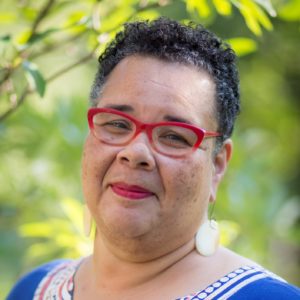
TMI: Over-sharing is NOT Caring
Classroom discussions are never to be used as therapy – by student or by teacher. While I believe teaching and learning has the capacity to summon the elements of healing, I do not subscribe to asking teacher or learner to participate in classroom sessions structured for therapy in any respect. The doing of therapy must be left to the psychological professionals. No assignment or classroom discussion should invite students into a therapeutic contract. I make this declaration because personal disclosures are often part of the teacher/learner relationship. Choosing authentic and healthy ways of revealing one’s self to students is a part of teaching, and it requires reflection, intention, planning, and great care.

Parker Palmer has taught us, “we teach who we are,” so it behooves us to take great care that in sharing ourselves we do not share our craziness, our brokenness, our hot-mess-selves. We should resist any temptation or impulse to disclose personal, raw stories of pain, trauma, and personal wounding under the guise of providing conceptual examples or building trust with our students. Students do not deserve to be burdened by our emotional or psychological fragilities. Equally, we must take care not to coax students into personal disclosures that continue, or compound, their wounding. In other words, too much shared personal information is never a way to strengthen the dynamics of a classroom discussion, lesson plan, or teaching relationship.
I have a colleague who does not subscribe to Palmer’s line of thinking about the teaching of one’s self. Instead, he subscribes to the notion that we teach through a series of personas that can be created, crafted, and honed. Then, over the years, by cultivating these personas, we can convey, portray, perform the self who is needed to be a good teaching presence in the classroom. This perspective reminds me of the poem “We Wear the Mask” by Paul Laurence Dunbar. The first stanza reads:
We wear the mask that grins and lies,
It hides our cheeks and shades our eyes,—
This debt we pay to human guile;
With torn and bleeding hearts we smile,
And mouth with myriad subtleties.
While I don’t think this is what my colleague intends, I suspect our adult learners are savvy enough that they recognize a good persona or a flimsy persona for just what it is - a persona. The irony is that even your choice of persona reveals a bit about who you are.
Regardless of your philosophy of self-disclosure, the key is not to over-share. Only a few of us are reckless and blindly cross boundaries or wantonly choose to participate in inappropriate disclosures that lead to inappropriate behaviors. Most of us are not in danger of harming students. Most of us simply want to find ways of portraying our healthiest selves for the good of the learning ecology.
The month when my mother was dying (2010), I was teaching as best I could - that is, only just barely. I thought I was doing an adequate job. One day during class my teaching assistant, Amy, pulled me aside and told me I had assigned the same small group exercise the week before. She looked at me with eyes afraid she had told me the wrong thing. I thanked her for her feedback. When I gathered the students back from the small groups, my first impulse was to explain myself, which would have meant telling the class I was distracted because my mother was dying. I recoiled from this disclosure feeling that it was too intimate, too raw, too much sharing. My next impulse was to continue with the planned discussion and end class a few minutes early. I went with my second impulse. Being authentic in classrooms does not mean telling all your business. Students are not in our classrooms to take care of us.
Similar practices and sensitivities are needed for student disclosures. I have had moments when adult learners launch into telling very personal, sometimes painful stories, about family situations. In these moments I ask them to “STOP!” I try to be light-hearted in my command to cease, but I ask that traumatic experiences not be told, then I ask the student to tell us the point of the story, rather than the detailed story itself. If needed, I talk with the student after class in an effort to refer him/her to counseling. Referral is a needed skill in teaching. Additionally, I ask that in written assignments, care be taken not to disclose anything to me that they would not disclose to the entire class. Reading the stories of pain and trauma in assignment form can be worse than hearing the stories told in the classroom setting.

I have a friend, brilliant scholar, who has chosen only to lecture in classroom sessions. Occasionally, she will turn to questions about the lecture in the last few minutes of the session. She has intentionally decided never to allow for student discussions. This strategy was deployed because she was weary of the personal stories of students that were nearly impossible to redirect toward the course agenda. She was unnerved by the disclosures of gossip which were used to thicken the discussion and entertain. She found it a waste of time to listen to students who had not done the readings and instead chose to filibuster by over-sharing. While I do not applaud her decision, I understand her decision.
The best strategies I know for helping students and myself not to lapse into disconnected, personal storytelling is to be clear about my aims, objectives, and goals for each course, each session, each learning activity and then to keep those goals central to all discussions. It takes a precision of discipline to stay on-target with the aims and to train students to respect these parameters of disclosure and discussion. It takes a strong, even hand to set and maintain a climate that encourages strong discourse (even personal stories which are applicable to the conversation) and discourages over-sharing. I start the first day of the class with this kind of climate setting in mind. I tell students that we do NOT have a contract of confidentiality in our discussions and to consider anything said in this space as shareable with the world. I tell them that if they need to speak confidentially, then please see their therapist, spiritual director, or counselor, as I will be doing the same thing. I have gotten considerable feedback from students that they appreciate not to be asked to over-share in classrooms.
Thank you for this piece, Dr. Westfield! I teach over 100 students a semester at a large public university and I am frequently overwhelmed by the various needs of students. Once a student told me I probably saved his life. Another time a student walked into my office and asked me if I am a counselor. A couple minutes of conversation with him and it was evident he was struggling with PTSD. Throughout my career, I have felt responsible for the mental health and personal well-being of my students, to the detriment of being an effective professor. Working to develop boundaries has been difficult as I’ve been socialized to be attuned to other people’s emotional needs and to value connection with other people above all else. Thank you so much for articulating your own work to establish boundaries. I learned so much from this very short piece!
Thank you so much for sharing this; it’s incredibly helpful.
With all due respect, it feels like this is a personal frustration that perhaps should be managed in private. The culture we live in has left students with few allies and challenges in navigating aspects of emotional intelligence. The problem is bigger than the teacher/student dynamic. It seems teachers must address this by demanding support, resources, pay, and benefits from the institutions and from the country they serve. Teachers have a responsibility to address these issues at an action level. When students see teachers demand their worth be recognized, the message is empowering. Why do students see teachers as someone they can “dump on”? Could it be because society is abusive to teachers through underpaying them? Nor does society provide resources or benefits or even a basic safe environment. Teachers can march, strike, and take actions to demonstrate they are secure in their value. For me, this is a teacher issue. Not a student issue.
With respect, I wish this article would come down. Teachers continue to allow unsafe classrooms where they may be shot, unfair pay, a sad lack of resources, and lack of empowerment. Showing students your personal value by marching, teaching strikes, and social media movements to demand recognition of your value as a teacher is a way for students to see you taking your power in action. It seems your frustrations ultimately lie with the system, not the student.